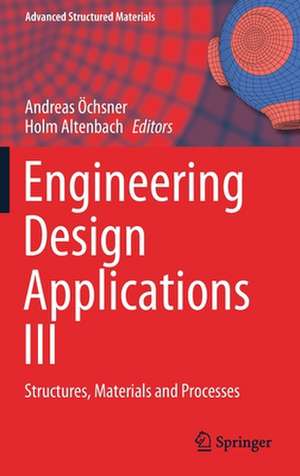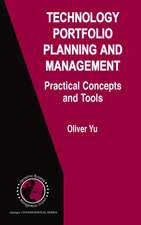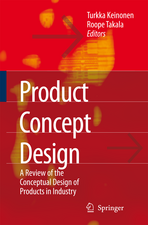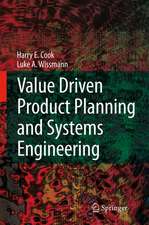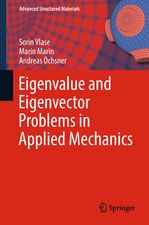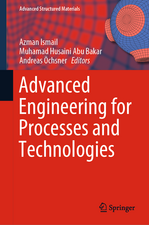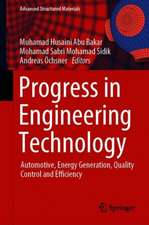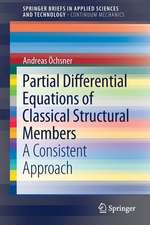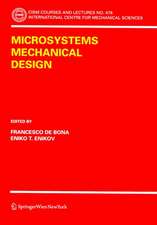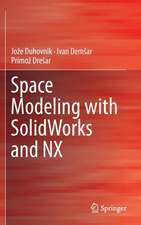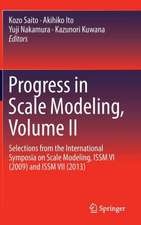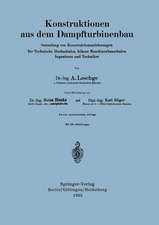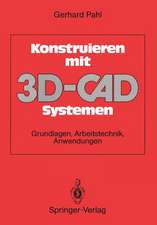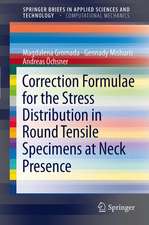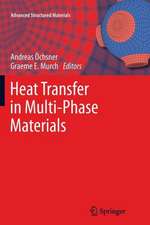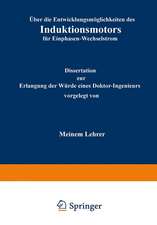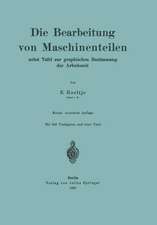Engineering Design Applications III: Structures, Materials and Processes: Advanced Structured Materials, cartea 124
Editat de Andreas Öchsner, Holm Altenbachen Limba Engleză Hardback – 6 mar 2020
| Toate formatele și edițiile | Preț | Express |
|---|---|---|
| Paperback (1) | 643.48 lei 6-8 săpt. | |
| Springer International Publishing – 6 mar 2021 | 643.48 lei 6-8 săpt. | |
| Hardback (1) | 649.87 lei 6-8 săpt. | |
| Springer International Publishing – 6 mar 2020 | 649.87 lei 6-8 săpt. |
Din seria Advanced Structured Materials
- 18%
 Preț: 949.90 lei
Preț: 949.90 lei - 18%
 Preț: 1011.27 lei
Preț: 1011.27 lei - 18%
 Preț: 1014.28 lei
Preț: 1014.28 lei - 18%
 Preț: 1109.16 lei
Preț: 1109.16 lei - 18%
 Preț: 1034.17 lei
Preț: 1034.17 lei - 15%
 Preț: 713.69 lei
Preț: 713.69 lei - 18%
 Preț: 1007.35 lei
Preț: 1007.35 lei - 18%
 Preț: 899.21 lei
Preț: 899.21 lei - 18%
 Preț: 1116.26 lei
Preț: 1116.26 lei - 18%
 Preț: 1120.99 lei
Preț: 1120.99 lei - 18%
 Preț: 785.55 lei
Preț: 785.55 lei - 18%
 Preț: 894.46 lei
Preț: 894.46 lei - 18%
 Preț: 1222.01 lei
Preț: 1222.01 lei - 18%
 Preț: 993.12 lei
Preț: 993.12 lei - 18%
 Preț: 792.66 lei
Preț: 792.66 lei - 18%
 Preț: 807.64 lei
Preț: 807.64 lei - 18%
 Preț: 1007.35 lei
Preț: 1007.35 lei - 18%
 Preț: 1120.18 lei
Preț: 1120.18 lei - 18%
 Preț: 1233.06 lei
Preț: 1233.06 lei - 18%
 Preț: 748.46 lei
Preț: 748.46 lei - 18%
 Preț: 1106.00 lei
Preț: 1106.00 lei - 18%
 Preț: 753.20 lei
Preț: 753.20 lei - 18%
 Preț: 780.82 lei
Preț: 780.82 lei - 18%
 Preț: 803.40 lei
Preț: 803.40 lei - 18%
 Preț: 798.18 lei
Preț: 798.18 lei - 18%
 Preț: 1123.35 lei
Preț: 1123.35 lei - 18%
 Preț: 901.64 lei
Preț: 901.64 lei - 18%
 Preț: 947.04 lei
Preț: 947.04 lei - 15%
 Preț: 643.65 lei
Preț: 643.65 lei - 15%
 Preț: 639.25 lei
Preț: 639.25 lei - 15%
 Preț: 661.65 lei
Preț: 661.65 lei - 18%
 Preț: 953.82 lei
Preț: 953.82 lei - 15%
 Preț: 646.62 lei
Preț: 646.62 lei - 18%
 Preț: 1229.10 lei
Preț: 1229.10 lei - 15%
 Preț: 637.78 lei
Preț: 637.78 lei - 15%
 Preț: 651.84 lei
Preț: 651.84 lei - 15%
 Preț: 641.71 lei
Preț: 641.71 lei - 15%
 Preț: 649.22 lei
Preț: 649.22 lei - 15%
 Preț: 658.70 lei
Preț: 658.70 lei - 5%
 Preț: 719.59 lei
Preț: 719.59 lei - 15%
 Preț: 645.79 lei
Preț: 645.79 lei - 15%
 Preț: 646.43 lei
Preț: 646.43 lei - 18%
 Preț: 936.29 lei
Preț: 936.29 lei - 18%
 Preț: 1231.16 lei
Preț: 1231.16 lei - 15%
 Preț: 645.28 lei
Preț: 645.28 lei
Preț: 649.87 lei
Preț vechi: 764.55 lei
-15% Nou
Puncte Express: 975
Preț estimativ în valută:
124.38€ • 129.37$ • 104.23£
124.38€ • 129.37$ • 104.23£
Carte tipărită la comandă
Livrare economică 13-27 martie
Preluare comenzi: 021 569.72.76
Specificații
ISBN-13: 9783030390617
ISBN-10: 3030390616
Ilustrații: X, 348 p. 230 illus., 135 illus. in color.
Dimensiuni: 155 x 235 mm
Greutate: 0.68 kg
Ediția:1st ed. 2020
Editura: Springer International Publishing
Colecția Springer
Seria Advanced Structured Materials
Locul publicării:Cham, Switzerland
ISBN-10: 3030390616
Ilustrații: X, 348 p. 230 illus., 135 illus. in color.
Dimensiuni: 155 x 235 mm
Greutate: 0.68 kg
Ediția:1st ed. 2020
Editura: Springer International Publishing
Colecția Springer
Seria Advanced Structured Materials
Locul publicării:Cham, Switzerland
Cuprins
1. Geometrical Characterization of a Lumbar Spine.- 2. Antigravity device for intravertebral rehabilitation.- 3. Simplified test bench used to reproduce child facial damage during a frontal collision.- 4. Scientific Visualization as a Tool for Signal Processing in EEG Interpretation: Car Driver Sleeping State Detection for Advanced Cars Control Systems.- 5. Determination, validation and dynamic analysis of an off-road chassis Mateus Coutinho de Moraes.
Notă biografică
Andreas Öchsner is a Full Professor of Lightweight Design and Structural Simulation at Esslingen University of Applied Sciences, Germany. Having obtained a Dipl.-Ing. degree in Aeronautical Engineering at the University of Stuttgart (1997), Germany, he served as a research and teaching assistant at the University of Erlangen-Nuremberg from 1997 to 2003, while working to complete his Doctor of Engineering Sciences (Dr.-Ing.) degree. From 2003 to 2006, he was an Assistant Professor at the Department of Mechanical Engineering and Head of the Cellular Metals Group affiliated with the University of Aveiro, Portugal. He spent seven years (2007–2013) as a Full Professor at the Department of Applied Mechanics, Technical University of Malaysia, where he was also Head of the Advanced Materials and Structure Lab. From 2014 to 2017, he was a Full Professor at the School of Engineering, Griffith University, Australia, and Leader of the Mechanical Engineering Program (Head of Discipline and Program Director).
Prof. Dr.-Ing. habil. Dr. h. c. mult Holm Altenbach is a member of the International Association of Applied Mathematics and Mechanics (GAMM) a Foreign Member of the Russian Academy of Sciences; and the International Research Center on Mathematics and Mechanics of Complex Systems (M&MoCS), Italy. He has held positions at the Otto von Guericke University Magdeburg and at the Martin Luther University of Halle-Wittenberg, both in Germany.
He graduated from Leningrad Polytechnic Institute in 1985 (diploma in Dynamics and Strength of Machines). He defended his Ph.D. in 1983 and was awarded his Doctor of Technical Sciences in 1987, both at the same institute. He is currently a Full Professor of Engineering Mechanics at the Otto von Guericke University Magdeburg, Faculty of Mechanical Engineering, Institute of Mechanics (since 2011), and has been acting as the Director of the Institute of Mechanics since 2015.
His areas of scientific interests are general theory of elastic and inelastic plates and shells, creep and damage mechanics, strength theories, and nano- and micromechanics. He is the Author/Co-Author/Editor of 60 books (textbooks/monographs/proceedings), approximately 380 scientific papers (among them 250 peer-reviewed), and 500 scientific lectures. He is Managing Editor (2004 to 2014) and Editor-in-Chief (2005–to date) of the Journal of Applied Mathematics and Mechanics (ZAMM) – the oldest journal in Mechanics in Germany (founded by Richard von Mises in 1921). He has been Advisory Editor of the journal “Continuum Mechanics and Thermodynamics” since 2011, Associate Editor of the journal “Mechanics of Composites” (Riga) since 2014, Doctor of Technical Sciences, and Co-Editor of the Springer Series “Advanced Structured Materials” since 2010.
He was awarded the 1992 Krupp Award (Alexander von Humboldt Foundation); 2000 Best Paper of the Year—Journal of Strain Analysis for Engineering Design; 2003 Gold Medal of the Faculty ofMechanical Engineering, Politechnika Lubelska, Lublin, Poland; 2004 Semko Medal of the National Technical University Kharkov, Ukraine; 2007 Doctor Honoris Causa, National Technical University Kharkov, Ukraine; 2011 Fellow of the Japanese Society for the Promotion of Science; 2014 Doctor Honoris Causa, University Constanta, Romania; 2016 Doctor Honoris Causa, Vekua Institute, Tbilisi, Georgia; 2018 Alexander von Humboldt Award (Poland).
Prof. Dr.-Ing. habil. Dr. h. c. mult Holm Altenbach is a member of the International Association of Applied Mathematics and Mechanics (GAMM) a Foreign Member of the Russian Academy of Sciences; and the International Research Center on Mathematics and Mechanics of Complex Systems (M&MoCS), Italy. He has held positions at the Otto von Guericke University Magdeburg and at the Martin Luther University of Halle-Wittenberg, both in Germany.
He graduated from Leningrad Polytechnic Institute in 1985 (diploma in Dynamics and Strength of Machines). He defended his Ph.D. in 1983 and was awarded his Doctor of Technical Sciences in 1987, both at the same institute. He is currently a Full Professor of Engineering Mechanics at the Otto von Guericke University Magdeburg, Faculty of Mechanical Engineering, Institute of Mechanics (since 2011), and has been acting as the Director of the Institute of Mechanics since 2015.
His areas of scientific interests are general theory of elastic and inelastic plates and shells, creep and damage mechanics, strength theories, and nano- and micromechanics. He is the Author/Co-Author/Editor of 60 books (textbooks/monographs/proceedings), approximately 380 scientific papers (among them 250 peer-reviewed), and 500 scientific lectures. He is Managing Editor (2004 to 2014) and Editor-in-Chief (2005–to date) of the Journal of Applied Mathematics and Mechanics (ZAMM) – the oldest journal in Mechanics in Germany (founded by Richard von Mises in 1921). He has been Advisory Editor of the journal “Continuum Mechanics and Thermodynamics” since 2011, Associate Editor of the journal “Mechanics of Composites” (Riga) since 2014, Doctor of Technical Sciences, and Co-Editor of the Springer Series “Advanced Structured Materials” since 2010.
He was awarded the 1992 Krupp Award (Alexander von Humboldt Foundation); 2000 Best Paper of the Year—Journal of Strain Analysis for Engineering Design; 2003 Gold Medal of the Faculty ofMechanical Engineering, Politechnika Lubelska, Lublin, Poland; 2004 Semko Medal of the National Technical University Kharkov, Ukraine; 2007 Doctor Honoris Causa, National Technical University Kharkov, Ukraine; 2011 Fellow of the Japanese Society for the Promotion of Science; 2014 Doctor Honoris Causa, University Constanta, Romania; 2016 Doctor Honoris Causa, Vekua Institute, Tbilisi, Georgia; 2018 Alexander von Humboldt Award (Poland).
Textul de pe ultima copertă
This book provides an update on recent advances in various areas of modern engineering design, such as mechanical, materials, computer, and process engineering, which provide the foundation for the development of improved structures, materials, and processes. The modern design cycle is characterized by the interaction of different disciplines and a strong shift toward computer-based approaches involving only a small number of experiments for verification purposes. A major driver for this development is the increased demand for cost reduction, which is also connected to environmental demands. In the transportation industry (e.g. automotive or aerospace), where there is a demand for greater fuel efficiency, one solution is lighter structures and/or improved processes for energy conversion. Another emerging area is the interaction of classical engineering with the health and medical sector.
Caracteristici
Discusses interaction between classical engineering and the health and medical sector Presents processes to achieve lighter structures Describes how to optimize operational costs and lower harm for the environment
